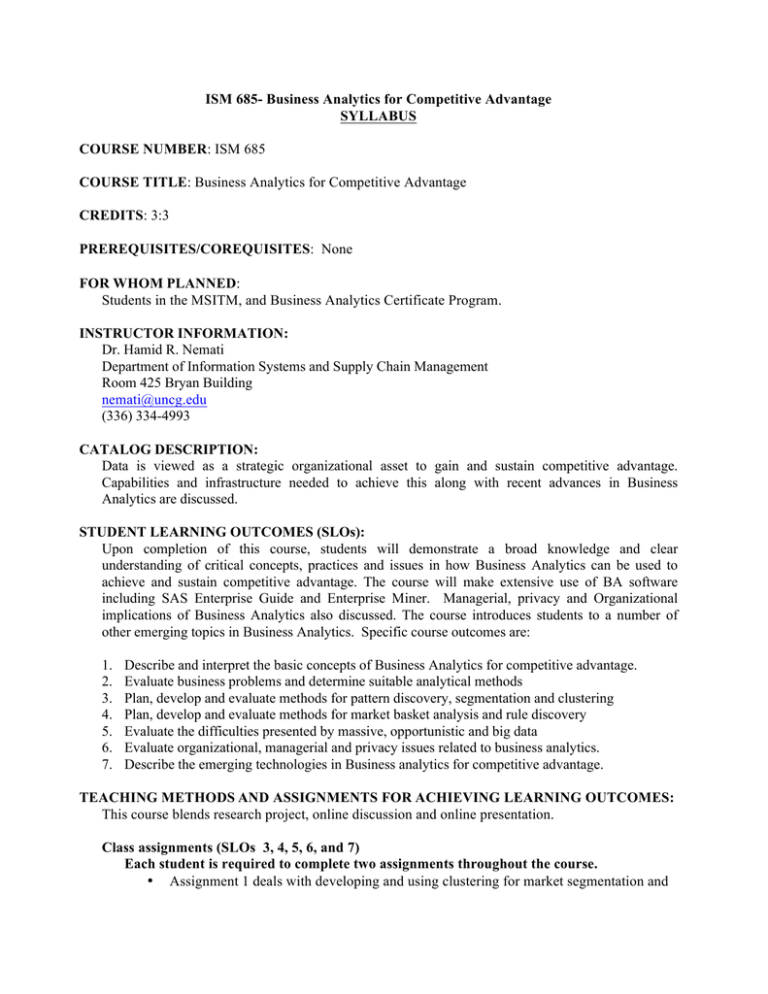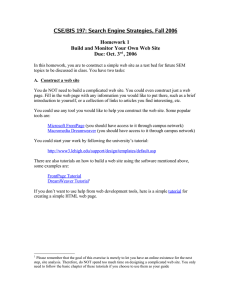ISM 685- Business Analytics for Competitive Advantage SYLLABUS COURSE NUMBER COURSE TITLE
advertisement

ISM 685- Business Analytics for Competitive Advantage SYLLABUS COURSE NUMBER: ISM 685 COURSE TITLE: Business Analytics for Competitive Advantage CREDITS: 3:3 PREREQUISITES/COREQUISITES: None FOR WHOM PLANNED: Students in the MSITM, and Business Analytics Certificate Program. INSTRUCTOR INFORMATION: Dr. Hamid R. Nemati Department of Information Systems and Supply Chain Management Room 425 Bryan Building nemati@uncg.edu (336) 334-4993 CATALOG DESCRIPTION: Data is viewed as a strategic organizational asset to gain and sustain competitive advantage. Capabilities and infrastructure needed to achieve this along with recent advances in Business Analytics are discussed. STUDENT LEARNING OUTCOMES (SLOs): Upon completion of this course, students will demonstrate a broad knowledge and clear understanding of critical concepts, practices and issues in how Business Analytics can be used to achieve and sustain competitive advantage. The course will make extensive use of BA software including SAS Enterprise Guide and Enterprise Miner. Managerial, privacy and Organizational implications of Business Analytics also discussed. The course introduces students to a number of other emerging topics in Business Analytics. Specific course outcomes are: 1. 2. 3. 4. 5. 6. 7. Describe and interpret the basic concepts of Business Analytics for competitive advantage. Evaluate business problems and determine suitable analytical methods Plan, develop and evaluate methods for pattern discovery, segmentation and clustering Plan, develop and evaluate methods for market basket analysis and rule discovery Evaluate the difficulties presented by massive, opportunistic and big data Evaluate organizational, managerial and privacy issues related to business analytics. Describe the emerging technologies in Business analytics for competitive advantage. TEACHING METHODS AND ASSIGNMENTS FOR ACHIEVING LEARNING OUTCOMES: This course blends research project, online discussion and online presentation. Class assignments (SLOs 3, 4, 5, 6, and 7) Each student is required to complete two assignments throughout the course. • Assignment 1 deals with developing and using clustering for market segmentation and 2 • designing market basket analysis (SLOs 3, 4) Assignment 2 deals with using social network data to develop and use text mining and sentiment analysis models. (SLOs 5, 6, 7) Case Analysis (SLOs 1, 2, 3, 4, 5, 6, 7) Each student is required to develop a comprehensive case analysis dealing with an emerging topic in business analytics. Class discussion and participation (SLOs 1, 2, 3, 4, 5, 6, 7) Each student is required to regularly discuss online with the instructor on project progress. Final Project and Report (SLO 6, 7) Each student must present a final research proposal and a final report on a topic of approved by the instructor. Final Exam (SLOs 1, 2, 3, 4, 5, 6, and 7) An on line timed final exams are required for class. The exam will test students on both the business analytics topics and the use of software. SOFTWARE NEEDED FOR THE COURSE: This course makes extensive use of SAS® Enterprise Miner™ 12.1 and Enterprise Guide 5.1 for this class. Students will have the option of downloading and installing their own copies of software or access the software through cloud computer services provided by SAS. The instruction for getting access to the software will be distributed to the students in the first week of class and will be available via course BlackBoard. EVALUATION AND GRADING: The course will be letter graded. A student’s final grade will depend on the quality of the project components. Assignments (2 @ 15% each) Class discussion and participation Case Analysis and Report Final Project and Report Final Exam 30% 5% 15% 30% 20% 100% The grade scale is based upon percent of points earned, and is as follows: 93-100%=A 73-76%=C 90-92%=A87-89%=B+ Below 73%=F 83-86%=B 80-82%=B- 77-79%=C+ TEXTS/READINGS/REFERENCES: This course is Web based and delivered on-line. All needed teaching material including text books and readings are available electronically via BlackBoard, Please sign into BlackBoard to gain access to the material. In addition to the text books, and other teaching material, articles from both academic and practitioner publications will be posted on the Blackboard. 3 1. Keeping Up with the Quants: Your Guide to Understanding and Using Analytics. By Thomas H. Davenport and Jinho Kim, Harvard Business Review Press, ISBN-13: 978-1422187258. (Q) 2. Predictive Analytics: The Power to Predict Who Will Click, Buy, Lie, or Die, By Eric Siegel, Wiley Press, ISBN-13: 978-1118356852. (P) 3. Competing on Analytics, Thomas Davenport. Harvard Business School Case Study, 2008. 4. Other case studies maybe added. Additional Optional and Supplemental Reading list: • “The Case for Investing in Business Analytics Technology,” by Dan Vesset Henry D. Morris • “Driven by Data: The Importance of Building a Culture of Fact-Based Decision-Making,” SAS Publishing • “What is Data Science? The future belongs to the companies and people that turn data into products,” by Mike Loukides • “The Forrester Wave: Big Data Predictive Analytics Solutions, Forrester Group Report, Available at Forrester.com • “The Signal And The Noise: Why So Many Predictions Fail — but Some Don’t’“, by Nate Silver. • “Emerging Trends in Business Analytics,” by Ron Kohavi, Neal J. Rothleder, and Evangelos Simoudis • “Big Data: The next frontier for innovation, Competition and productivity,” McKinsey Report, 2012 • “Protecting Personal Privacy: Hauling Down the Jolly Roger,” by Michael Lesk • “Defining Privacy for Data Mining,” by Chris Clifton Murat Kantarcioglu Jaideep Vaidya TOPICAL OUTLINE/CALENDAR: Week Topics Week 1 • Introduction to Business Analytics for Competitive Advantage Weeks 2 and 3 • • Pattern Discovery Clustering and profiling Weeks 4 • • • Association Rule Discovery Link Analysis Market Segmentation Weeks 5 and 6 • • Social Network Analytics Assignment 1 Due Weeks 7, 8 • • • Text Analytics Sentiment Analytics Case Study Due • Big Data Analytics Weeks 9, 10 4 Weeks 11, 12 • • Privacy Implications of Business Analytics Assignment 2 Due Weeks 13 • • Cloud Computing and Business Analytics Issues Managerial and Business Issues Week 14 • • Final exam Final Project Due ACADEMIC INTEGRITY POLICY: Each student is required to sign the Academic Integrity Policy on all major work submitted for the course. The Academic Integrity Policy can be found at: http://sa.uncg.edu/handbook/academic-integrity-policy/. FACULTY AND STUDENT GUIDELINES: The faculty and students in the course are expected to adhere to the faculty student guidelines stated at the following web page: http://www.uncg.edu/bae/faculty_student_guidelines.pdf ATTENDANCE POLICY: Since it is an online class, no physical class-room attendance is required. It is the student’s responsibility to stay on track with readings and assignments to be successful in the course.







